|
|
|
|
|
 |
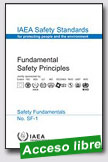 |
Fundamental
Safety Principles
IAEA, 2006, 21 p.
This
publication states the fundamental safety objective and
ten associated safety principles, and briefly describes
their intent and purpose. The fundamental safety
objective — to protect people and the environment from
harmful effects of ionizing radiation — applies to all
circumstances that give rise to radiation risks. The
safety principles are applicable, as relevant,
throughout the entire lifetime of all facilities and
activities — existing and new — utilized for
peaceful
|
|
purposes,
and to protective actions to reduce existing radiation
risks. They provide the basis for requirements and
measures for the protection of people and the
environment against radiation risks and for the safety
of facilities and activities that give rise to radiation
risks, including, in particular, nuclear installations
and uses of radiation and radioactive sources, the
transport of radioactive material and the management of
radioactive waste.
extraído
de:
http://www-pub.iaea.org/MTCD/publications/PubDetails.asp?pubId=7592
|
 |
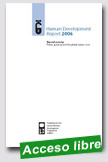 |
The
2006 Human Development Report. Beyond scarcity: Power,
poverty and the global water crisis
United
Nations Development Program, 2006, 440 p.
Throughout
history water has confronted humanity with some of its
greatest challenges. Water is a source of life and a
natural resource that sustains our environments and
supports livelihoods – but it is also a source of risk
and vulnerability. In the early 21st Century, prospects
for human development are
|
|
threatened
by a deepening global water crisis. Debunking the myth
that the crisis is the result of scarcity, this report
argues poverty, power and inequality are at the heart of
the problem.
In
a world of unprecedented wealth, almost 2 million
children die each year for want of a glass of clean
water and adequate sanitation. Millions of women and
young girls are forced to spend hours collecting and
carrying water, restricting their opportunities and
their choices. And water-borne infectious diseases are
holding back poverty reduction and economic growth in
some of the world’s poorest countries.
Beyond
the household, competition for water as a productive
resource is intensifying. Symptoms of that competition
include the collapse of water-based ecological systems,
declining river flows and large-scale groundwater
depletion. Conflicts over water are intensifying within
countries, with the rural poor losing out. The potential
for tensions between countries is also growing, though
there are large potential human development gains from
increased cooperation.
The
Human Development Report continues to frame debates on
some of the most pressing challenges facing
humanity.
extraído
de:
http://hdr.undp.org/hdr2006/pdfs/report/HDR06-complete.pdf
|
 |
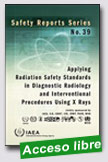 |
Applying
Radiation Safety Standards in Diagnostic Radiology and
Interventional Procedures Using X Rays
IAEA, 2006, 96 p.
The International Basic
Safety Standards for Protection against Ionizing
Radiation and for the Safety of Radiation Sources (BSS),
jointly sponsored, inter alia, by the IAEA, ILO, WHO and
PAHO, establish requirements on the legal persons
responsible for designing, running and
|
|
decommissioning practices
involving ionizing radiation. These requirements are
basic and general in nature. This report is intended to
be of assistance to both regulators and users of
radiation sources in diagnostic radiology and
interventional procedures using X rays in applying the
BSS to this practice. Regulators will find it useful for
reviewing applications for authorization and for the
inspection of the practice. Users of radiation in
radiology may follow the guidance provided in order to
comply with BSS requirements or equivalent national
requirements. Experts recruited on IAEA missions to
advise on the implementation of the BSS for the practice
of diagnostic radiology and interventional procedures
using X rays are expected to use this regulatory
guidance report rather than their own national
regulations and guidance.
extraído de:
http://www-pub.iaea.org/MTCD/publications/PubDetails.asp?pubId=7115 |
 |
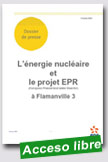

|
L’énergie
nucléaire et le projet EPR (European Pressurized water
Reactor)
EDF,
Octobre 2006, s.p.
EDF
et les opérateurs nucléaires internationaux
travaillent sur des réacteurs «nouvelle génération»
plus sûrs, plus compétitifs et plus respectueux encore
de l'environnement. Version évoluée de réacteurs
actuels, l'EPR (European Pressurized Reactor) fait
partie de ces nouvelles technologies nucléaires.
Le 4 mai 2006, EDF a décidé, suite au débat public
dont le contenu a fait l'objet d'un rapport publié le
11 avril 2006, d'engager la réalisation d'une troisième
unité de production sur le site de Flamanville de type
EPR (European Pressurized Reactor). Le "1er béton"
du réacteur devrait débuter fin 2007 pour une mise en
service en 2012. Développé par des équipes françaises
et allemandes, notamment l'ingénierie d'EDF, l'EPR
cumule tous les progrès récents en matière de |
|
sûreté,
de sécurité, de respect de l'environnement et de
rentabilité économique. Il présente une continuité
technique avec les centrales existantes dont il intègre
le retour d'expérience. Sa réalisation maintenant
donnera à EDF le temps d'éprouver ce nouveau modèle
de réacteur avant de lancer - si la décision est prise
le moment venu - une série de réacteur en vue du
remplacement des centrales actuelles qui pourraient être
arrêtées.
Lors
du débat public sur le projet Flamanville 3 qui s’est
déroulé du 19 octobre 2005 au 18 février 2006, EDF
s’est engagé à diffuser une version publique du
Rapport Préliminaire de Sûreté de Flamanville 3. Ce
document est destiné à donner à tous une vision précise,
technique et exhaustive du projet, Flamanville 3. Il
marque la volonté d’EDF, de réaliser ce projet en
toute transparence.
extraído
de:
http://www.edf.fr/35054i/Accueil-fr/Infos-Nucleaire/Le-nucleaire-du-futur/L-EPR.html
|
 |
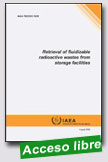 |
Retrieval
of Fluidizable Radioactive Wastes from Storage
Facilities
IAEA,
October 2006, 142 p.
Some
radioactive wastes arising at nuclear facilities have
been stored for an extended period of time, often beyond
the expected life of the storage vessels. IAEA Member
States are moving forward with actions to retrieve such
wastes for safe disposition. This document covers the
development of waste retrieval systems, with a specific
focus on the safe removal and transfer of wastes which
are in fluid form or
|
|
which
can be mobilised as a wet or dry media. Detailed
discussions are included on retrieval methodology,
technologies and approaches. Extensive examples are
provided for 21 waste retrieval projects completed or
currently underway around the world, including lessons
learned.
extraído
de:
http://www-pub.iaea.org/MTCD/publications/PubDetails.asp?pubId=7516
|
 |
|
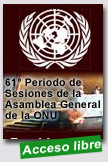
|
Informe
del Comité Científico de las Naciones Unidas para el
Estudio de los Efectos de las Radiaciones Atómicas
Naciones
Unidas, Asamblea General, Sexagésimo primer período de
sesiones, 2006, Sup. Nº 46 (A/61/46), 26 p.
Comité
Científico de las Naciones Unidas para el Estudio de
los Efectos de las
Radiaciones Atómicas. Informe sobre el 54º período
de sesiones (29 de mayo a 2 de junio de 2006).
|
|
extraído de:
Link
-
http://www.un.org/spanish/aboutun/organs/ga/61/doc.shtml
|
 |
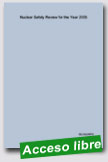 |
Nuclear
Safety Review for the Year 2005
IAEA,
August 2006, 72 p.
The
Nuclear Safety Review for the Year 2005 reports on
worldwide efforts to strengthen nuclear, radiation,
transport and radioactive waste safety and emergency
preparedness.
A
short analytical overview is supported by more detailed
Annexes: Safety Related Events and
|
|
Activities
Worldwide during 2005 (Annex 1), The Agency’s Safety
Standards: Activities during 2005 (Annex 2) and Civil
Liability for Nuclear Damage: International Expert Group
on Nuclear Liability (INLEX) (Annex 3).
A
draft Nuclear Safety Review for the Year 2005 was
submitted to the March 2006 session of the Board of
Governors in document GOV/2006/4. The final version of
the Nuclear Safety Review for the Year 2005 was prepared
in the light of the discussions in the Board.
extraído de:
http://www.iaea.org/About/Policy/GC/GC50/GC50Inf
Documents/English/gc50inf-2_en.pdf
|
 |
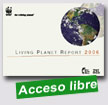 |
Living
Planet Report 2006
WWF,
2006, 44 p.
Humanity's
demands exceed our planet's capacity to sustain us. The
Living Planet Report is WWF's periodic update on the
state of the world's ecosystems. It describes the
changing state of global biodiversity and the pressure
on the biosphere arising from human consumption of
natural
|
|
resources.
It is built around two indicators: the Living Planet
Index, which reflects the health of the planet’s
ecosystems; and the Ecological Footprint, which shows
the extent of human demand on these ecosystems. These
measures are tracked over several decades to reveal past
trends, then three scenarios explore what might lie
ahead. The scenarios show how the choices we make might
lead to a sustainable society living in harmony with
robust ecosystems, or to the collapse of these same
ecosystems, resulting in a permanent loss of
biodiversity and erosion of the planet’s ability to
support people.
extraído de:
http://assets.panda.org/downloads/living_planet_report.pdf
|
 |
|
|
|
|
|
|
|
|
|
|
|
|
|
|
|
|
|
|
|
|
|
|
|
|
|
|
|
|
|
|
|
|
|
|
